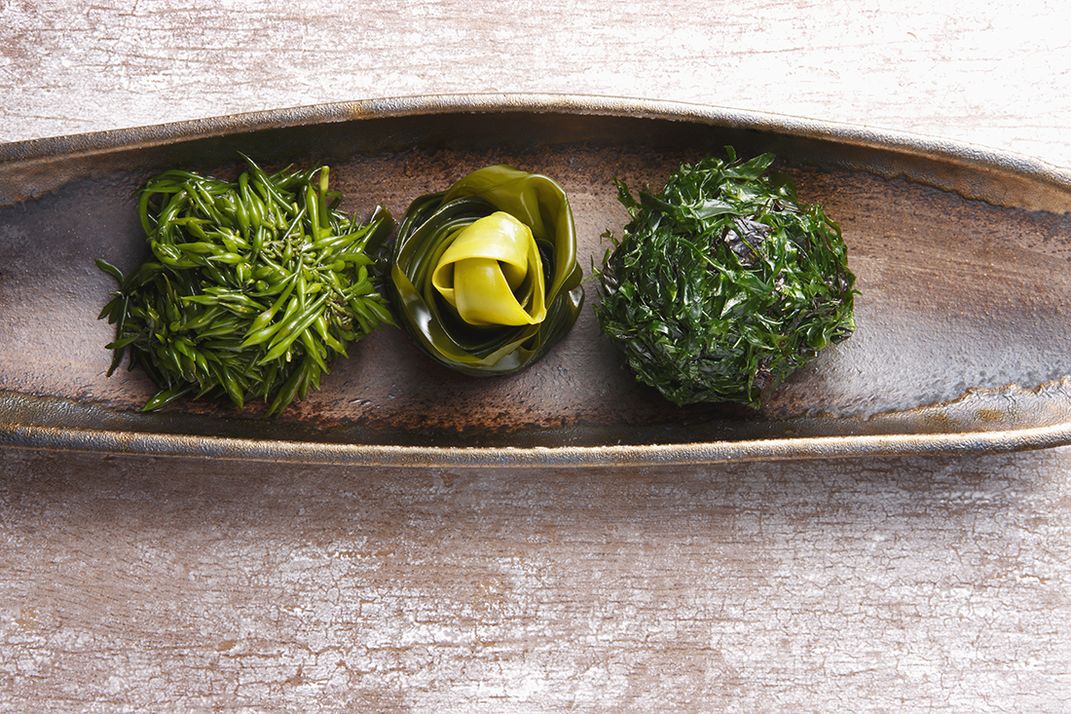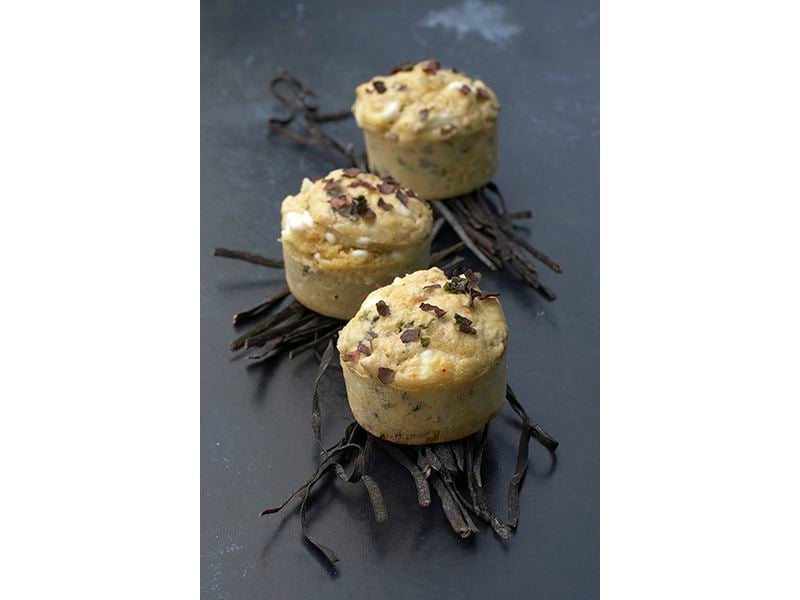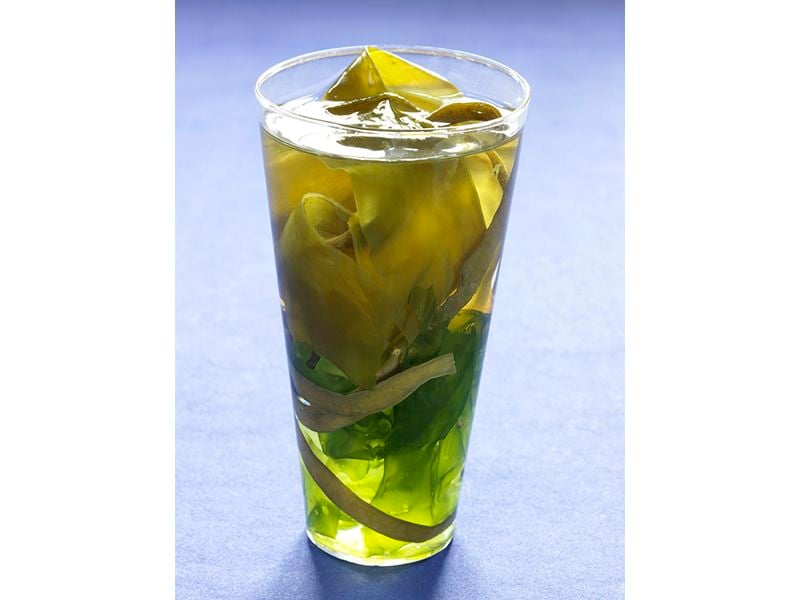Five Ways to Eat Seaweed
For years a staple of Asian cuisine, the leafy green is becoming a popular new “super food” in the U.S.
:focal(387x520:388x521)/https://tf-cmsv2-smithsonianmag-media.s3.amazonaws.com/filer/15/1a/151a8124-075e-41a6-bfcc-a60df585d23d/seaweed-soup-1072.jpg)
There's a small seaside village in Okinawa, Japan, where more than 100 of its 3221 residents are over 90-years-old. This isn't some retirement community—Ogimi Village is actually renowned for its longevity. It's a quality locals contribute in large part to their diet, which includes locally grown vegetables and freshly foraged foods such as seaweed. This wild algae that's prevalent along our shores and always getting tangled in our fishing hooks is a dietary staple throughout much of Asia. Now it's finally gaining mainstream recognition in the States. Chefs like Michael Cimarusti at Providence in L.A. and Trevor Moran at Nashville's The Catbird Sea have been incorporating this superfood—a source of vitamins A and C as well as both calcium and iodine, and loaded with antioxidants—into everything from broth to garnishes, and it's also seeing play as a star ingredient.
While not all seaweed is edible (experts specifically recommend steering clear of Hijiki, which contains high levels of inorganic arsenic), those that are have a surprising diversity to them. These include red algae such as nori, which is best known as a sushi wrap; brown algae like wakame or kelp; and green algae or 'sea lettuce.' Seaweed can be bought dried or fresh and is readily available at natural and health food stores. Here are five suggestions for preparing it in your culinary endeavors.
In Soup: Kombu is a type of kelp seaweed and a flavor enhancer for dashi, a cooking stock that's the base of miso soup. To make dashi simply heat a 1/2 ounce of dried kombu strips in 4.5 cups of water, let it simmer for about 10 minutes and then add katsuobushi—or dried bonito flakes. Turn off the heat, let the mixture sit for another 10 minutes or so, then strain. It's this strained, golden-hued liquid that is dashi.
Seaweed also works well as a main ingredient, like in this recipe for Shiitake Mushroom Miso Soup, which incorporates both kombu and wakame. Korean Seaweed Soup is another good one. It uses dried seaweed, and often includes sirloin, clams, or mussels.
/https://tf-cmsv2-smithsonianmag-media.s3.amazonaws.com/filer/49/0b/490bea87-f163-4426-a849-7d9c59d8b3eb/seaweed-salad-1072.jpg)
2. In Salad: Seaweed is a great substitute for spinach or lettuce. Try whole leaves of purple dulse as a base and toss it with crisp apples and red cabbage, or mix wild nori, toasted with tofu, shallots, pecans, and wild rice. Soak dried wakame in warm water until it expands, and you have the base for a traditional Japanese seaweed salad, the kind often served in sushi restaurants. You can also sprinkle crispy bits of seaweed on a traditional salad, or grind up bits of dried seaweed to use instead of salt.

3. As a Snack: Being low in calories and sporting endless health benefits, seaweed makes an ideal between-meal treat. Spread seaweed tapenade onto toast points for the perfect hiking snack, or bake up some seaweed muffins to take with you on the go. For something a little lighter with a bit of added spice, try these nori crisps with wasabi. Seaweed snacks are also popping up in markets like Whole Foods and Trader Joe's.

4. As Dessert: Sure it doesn't sound as appetizing as say, a warm chocolate cake, but there are many ways to incorporate seaweed into your post meal offerings that'll leave you satisfied and even hankering for more. Seaweed pudding, typically made with Irish Moss, is a popular dessert in Europe's Atlantic coastal towns. Spice it up by adding berries, unsweetened chocolate, or even an Irish whiskey like Bailey's. For something even richer, try this recipe for seaweed brownies. It includes tiny strips of dulce seaweed for an extra boost of nutrition. Author and former SF Bay Area pastry chef even came up with a recipe for sugar cookies flavored with seaweed salt.

5. Drink it: Still feel like the idea of incorporating sea algae into your cuisine is a little too out there? Why not skip the edible part and sip your seaweed instead. For years the Japanese have been drinking kombu tea, made with either kombu powder available at natural foods stores or thinly sliced strips of the kelp seaweed. The Irish Moss is a popular drink across the Caribbean. Along with its namesake seaweed it includes sweetened milk, spices and rum. At the soon-to-open restaurant Dirty Habit in San Francisco, CA, bar manager Brian Means will be offering his Dram at Mount Tam, a cocktail that mixes two ounces of St. George Terroir Gin with one ounce kombu-infused Vya vermouth, a half ounce of kale cordial, and four dashes of celery bitters. It's served strained over ice in an Old Fashioned glass with a lime twist—an easy-to-make 'at home' drink.
/https://tf-cmsv2-smithsonianmag-media.s3.amazonaws.com/accounts/headshot/LauraKiniry.png)
/https://tf-cmsv2-smithsonianmag-media.s3.amazonaws.com/accounts/headshot/LauraKiniry.png)